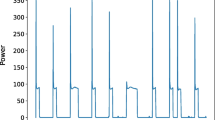Abstract
Many energy time series captured by real-time systems contain errors or anomalies that prevent accurate forecasts of time series evolution. However, accurate forecasting of load time series and fluctuating renewable energy feed-in as well as subsequent optimisation of the dispatch of controllable generators, storage and loads is crucial to ensure a cost-effective, sustainable and reliable energy supply. Therefore, we investigate methods and approaches for a system solution that automatically detect and replace anomalies in time series to enable accurate forecasts. Here, we introduce a hybrid anomaly detection system for energy consumption time series, which consists of two different neural networks (Seq2Seq and autoencoder) and two more classical approaches (entropy, SVM classification). This network is able to detect different types of anomalies, namely, outliers, zero points, incomplete data, change points and anomalous (parts of) time series. These types are defined for the first time mathematically. Our results show a clear advantage of the hybrid modelling approach for detecting anomalies in previously unknown energy time series compared to the single approaches. In addition, due to the generalisation capability of the hybrid model, our approach allows very good estimation of energy values without requiring a large amount of historical data to train the model.
Access this chapter
Tax calculation will be finalised at checkout
Purchases are for personal use only
Similar content being viewed by others
References
Bundesnetzagentur.: SMARD | SMARD - Strommarktdaten, Stromhandel und Stromerzeugung in Deutschland, Mar 2021. [Online; accessed 12. Mar. 2021]
Chaitanya, C.R.A., Kaplanyan, A.S., Schied, C., Salvi, M., Lefohn, A., Nowrouzezahrai, D., Aila, T.: Interactive reconstruction of monte carlo image sequences using a recurrent denoising autoencoder. ACM Trans. Graph. (TOG) 36(4), 1–12 (2017)
Chen, W., Zhou, K., Yang, S., Wu, C.: Data quality of electricity consumption data in a smart grid environment. Renewable and Sustainable Energy Reviews 75, 98–105 (2017)
Goldberg, D., Shan, Y.: The importance of features for statistical anomaly detection. In: 7th {USENIX} Workshop on Hot Topics in Cloud Computing (HotCloud 15) (2015)
Gong, G., An, X., Mahato, N. K., Sun, S., Chen, S., Wen, Y.: Research on short-term load prediction based on seq2seq model. Energies 12(16), 3199 (2019)
Hwang, S., Jeon, G., Jeong, J., Lee, J.: A novel time series based seq2seq model for temperature prediction in firing furnace process. Procedia Comput. Sci. 155, 19–26 (2019)
Kirkos, E., Spathis, C., Manolopoulos, Y.: Support vector machines, decision trees and neural networks for auditor selection. J. Comput. Methods Sci. Eng. 8(3), 213–224 (2008)
Klein, G., Kim, Y., Deng, Y., Senellart, J., Rush, A.: OpenNMT: Open-source toolkit for neural machine translation. In: Proceedings of ACL 2017, System Demonstrations (July 2017), pp. 67–72
Kummerow, A., Klaiber, S., Nicolai, S., Bretschneider, P., System, A.: Recursive analysis and forecast of superimposed generation and load time series. In: International ETG Congress 2015; Die Energiewende - Blueprints for the New Energy Age, pp. 1–6 (2015)
Laptev, N., Amizadeh, S., Flint, I.: Generic and scalable framework for automated time-series anomaly detection. In: Proceedings of the 21th ACM SIGKDD International Conference on Knowledge Discovery and Data Mining, 1939–1947 (2015)
Liguori, A., Markovic, R., Dam, T. T. H., Frisch, J., van Treeck, C., Causone, F.: Indoor environment data time-series reconstruction using autoencoder neural networks. Preprint (2020). arXiv:2009.08155
Shannon, C.E.: A mathematical theory of communication. Bell Syst. Tech. J. 27(3), 379–423 (1948)
Sherstinsky, A.: Fundamentals of recurrent neural network (rnn) and long short-term memory (lstm) network. Phys. D Nonlinear Phenomena 404, 132306 (2020)
Tewari, A., Zollhofer, M., Kim, H., Garrido, P., Bernard, F., Perez, P., Theobalt, C.: Mofa: Model-based deep convolutional face autoencoder for unsupervised monocular reconstruction. In: Proceedings of the IEEE International Conference on Computer Vision Workshops, pp. 1274–1283 (2017)
von Werra, L., Tunstall, L., Hofer, S.: Unsupervised anomaly detection for seasonal time series. In: 2019 6th Swiss Conference on Data Science (SDS), pp. 136–137 (2019)
Wang, M., Deng, W.: Deep visual domain adaptation: A survey. Neurocomputing 312, 135–153 (2018)
Xu, D., Tian, Y.: A comprehensive survey of clustering algorithms. Ann. Data Sci. 2(2), 165–193 (2015)
Yu, Y., Zhu, Y., Li, S., Wan, D.: Time series outlier detection based on sliding window prediction. Math. Prob. Eng. 2014, Article ID 879736 (2014). https://doi.org/10.1155/2014/879736
Zhang, Y., Chen, W., Black, J.: Anomaly detection in premise energy consumption data. In: 2011 IEEE Power and Energy Society General Meeting, pp. 1–8 (07 2011)
Acknowledgements
The work was financially supported by BMBF (Bundesministeriums für Bildung und Forschung) under the project “reDesigN - Resilience By Design for IoT Platforms in Distributed Energy Management” [1] (support code 01IS18074D) and Fraunhofer Cluster of Excellence Integrated Energy Systems (CINES). The authors want to acknowledge Prof Mäder and M. Sc. Martin Rabe (TU Ilmenau) for their supervision of the master thesis “Automatic energy data processing based on machine learning algorithms” of one of us (F.R.). Additionally, we thank B. Sc. Jonathan Schäfer (FSU Jena) for the fruitful discussions about the mathematical definition of the anomaly types.
Author information
Authors and Affiliations
Corresponding author
Editor information
Editors and Affiliations
Rights and permissions
Copyright information
© 2023 The Author(s), under exclusive license to Springer Nature Switzerland AG
About this paper
Cite this paper
Rippstein, F., Lenk, S., Kummerow, A., Richter, L., Klaiber, S., Bretschneider, P. (2023). Anomaly Detection Algorithm Using a Hybrid Modelling Approach for Energy Consumption Time Series. In: Valenzuela, O., Rojas, F., Herrera, L.J., Pomares, H., Rojas, I. (eds) Theory and Applications of Time Series Analysis and Forecasting. ITISE 2021. Contributions to Statistics. Springer, Cham. https://doi.org/10.1007/978-3-031-14197-3_2
Download citation
DOI: https://doi.org/10.1007/978-3-031-14197-3_2
Published:
Publisher Name: Springer, Cham
Print ISBN: 978-3-031-14196-6
Online ISBN: 978-3-031-14197-3
eBook Packages: Mathematics and StatisticsMathematics and Statistics (R0)




